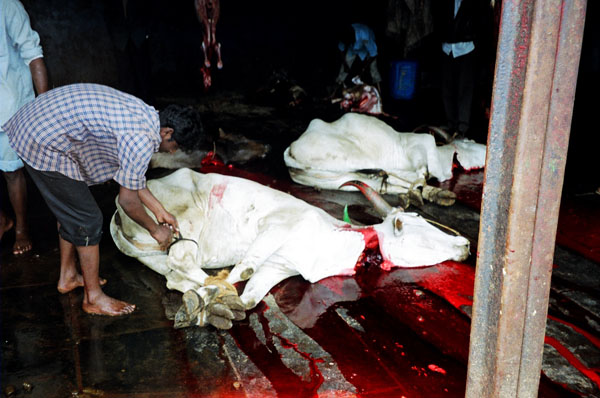While the mantle of the world largest beef exporting nation has traditionally been a three-way race between Australia, Brazil and the US, 2012 has seen India race ahead of the pack, with expectations for Indian beef exports to grow again in 2013
Export forecasts released by the United States Department of Agriculture (USDA) Foreign Agricultural Service points to Indian beef exports reaching 2.16 million tons cwt in 2013, up from a world leading 1.68 million tons cwt in 2012 – with the next closest nation in 2013, Brazil, shipping 1.45 million tons cwt.
Compared to the 29% year-on-year rise forecast in Indian beef exports in 2013, Brazilian and Australian (1.41 million tons cwt) beef exports are only expected to increase 4% and 2%, respectively.
 Given a falling cattle herd and constrained beef production, US beef exports in 2013 are forecast to decline 1.1% year-on-year, to 1.1 million tons cwt.
Given a falling cattle herd and constrained beef production, US beef exports in 2013 are forecast to decline 1.1% year-on-year, to 1.1 million tons cwt.
The rapid growth in Indian exports over the past five years has grabbed the attention of the other major beef exporting nations, with all exporters very closely monitoring the expanding global footprint created by Indian beef.
According to the USDA, in 2012 Indian beef accounted for nearly a quarter of the world beef trade, compared to just 8% in 2009. Indeed, in 2009, India is reported to have shipped 609,000 tons cwt, which would have placed it as the fifth largest nation, behind Argentina.
On the demand side of the equation, the rapid expansion of Indian beef shipments has been met by robust demand for lean and low priced beef, largely across the Middle East, Africa and southern Asia.
According to the USDA, the ability to provide halal product has also added to the attraction of Indian beef across numerous markets.
 From an Australian perspective, while Indian beef does not have access to major markets, including Japan, Korea and the US, there are several smaller markets where Australian and Indian beef competes.
From an Australian perspective, while Indian beef does not have access to major markets, including Japan, Korea and the US, there are several smaller markets where Australian and Indian beef competes.
The most notable of these is Malaysia, where in 2011 Indian beef imports maintained 82% market share, with Australia next, at 13%.
From a supply viewpoint, India’s potential to sell beef into the world market is substantial. With the world’s largest bovine herd (this includes both cattle and buffalo), forecast to reach 327.3 million head in 2013, annual beef production is well below that of nations with much smaller herds.
In 2013, Indian beef production is tipped to reach 4.17 million tons cwt, compared to 11.27 million tons cwt in the US, which has a herd of around 90 million head.According to the USDA, while Indian laws prohibit the slaughter of cattle for religious reasons, buffalo slaughter is allowed, but restricted to bulls and unproductive heifers.
Additionally, the financial incentive to salvage and sell buffalo calves for slaughter is contributing to the rising beef supplies, albeit with average carcase weights remaining very low compared to other countries (USDA). (Argentine Beef Packers SA)
source
# Do not kill cows and bulls who always deserve to be protected. (Yajurveda 13.49)
# In Rigveda cow slaughter has been declared a heinous crime equivalent to human murder and it has been said that those who commits this crime should be punished. (Rigveda 7.56.17)
# The Aghnya cows “ which are not to be killed under any circumstances“ may keep themselves healthy by use of pure water and green grass, so that we may be endowed with virtues, knowledge and wealth. (Rigveda 1.164.40 or Atharv 7.73.11 or Atharv 9.10.20)
# The Vedic Lexicon, Nighantu, gives amongst other synonyms of Gau [or cow] the words Aghnya. Ahi, and Aditi. Yaska the commentator on Nighantu, defines these as-
Aghnya the one that ought not to be killed
Ahi the one that must not be slaughtered.
Aditi the one that ought not to be cut into pieces.
These three names of cow signify that the animal ought not to be put to tortures. These words appear frequently throughout the Vedas in context of the cow.
# Cow – The aghnya – brings us health and prosperity. (Rigveda 1.164.27)
# There should be excellent facility for pure water for Aghnya Cow. (Rigveda 5.83.8)
# Those who feed on human, horse or animal flesh and those who destroy milk-giving Aghnya cows should be severely punished. (Rigveda 10.87.16)
# The Aghnya cows and bulls bring you prosperity. (Yajurveda 12.73)
# Do not kill the cow. Cow is innocent and aditi – that ought not to be cut into pieces. (Rigveda 8.101.15)
# Destroy those who kill cows. (Yajurveda 30.18)
# If someone destroys our cows, horses or people, kill him with a bullet of lead.(Atharvaveda 1.16.4)
# The entire 28th Sukta or Hymn of 6th Mandal of Rigveda sings the glory of cow.
1) Everyone should ensure that cows are free from miseries and kept healthy.
2) God blesses those who take care of cows.
3) Even the enemies should not use any weapon on cows
4) No one should slaughter the cow
5) Cow brings prosperity and strength
6) If cows keep healthy and happy, men and women shall also keep disease free and prosperous
7) May the cow eat green grass and pure water. May they not be killed and bring prosperity to us.
What more proofs does one need to understand the high esteem in which not only the cow but each living being is held in the Vedas.The learned audience can decide for themselves from these evidences that the Vedas are completely against any inhuman practice… to top it all the Beef and Cow slaughter.






























